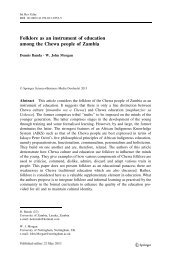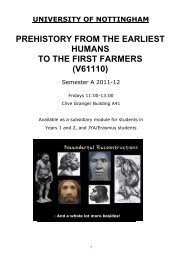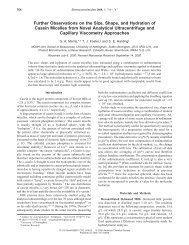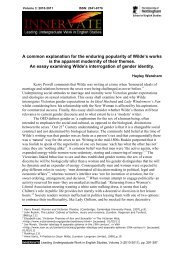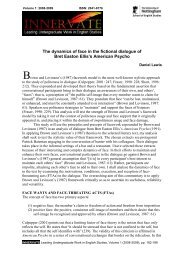Honouring the Dead in the Peloponnese - University of Nottingham
Honouring the Dead in the Peloponnese - University of Nottingham
Honouring the Dead in the Peloponnese - University of Nottingham
Create successful ePaper yourself
Turn your PDF publications into a flip-book with our unique Google optimized e-Paper software.
χρονικές περιόδους και με διαφορετικό κάθε φορά περιεχόμενο. Μετά την αναλυτική<br />
παρουσίαση της αρχιτεκτονικής και των κτερισμάτων του τάφου, εξετάζονται τα<br />
στοιχεία της ηρωολατρείίας, όπως ερμήνευσε ο ανασκαφέας τα πλούσια κατάλοιπα της<br />
ύστερης Γεωμετρικής περιόδου μέσα και πάνω από το θάλαμο. Σχολιάζεται επίσης η<br />
γειτνίαση των σημαντικών ταφικών μνημείων (Κύκλος Β, θολωτός Κλυταιμνήστρας,<br />
θαλαμωτός τάφος) με το ελληνιστικό θέατρο της πόλης, όπου αναβίωναν τα πάθη των<br />
Ατρειδών. Τέλος, αποτίεται φόρος τιμής στον ανασκαφέα, τα ημερολόγια του οποίου<br />
αποκαλύπτουν τις σκέψεις ενός μεγάλου αρχαιολόγου και τις ανησυχίες ενός<br />
καθημερινού ανθρώπου.<br />
18 Angeliki Kossyva. The <strong>in</strong>visible dead <strong>of</strong> Delpriza, Kranidi<br />
Despite <strong>the</strong> wealth <strong>of</strong> data for habitation <strong>in</strong> <strong>the</strong> sou<strong>the</strong>rn Argolid from very early times, very<br />
little is known about <strong>the</strong> framework <strong>of</strong> society and its economy dur<strong>in</strong>g <strong>the</strong> Early Bronze Age<br />
as it can be established through <strong>the</strong> burials and <strong>the</strong> behaviour <strong>of</strong> <strong>the</strong> community towards <strong>the</strong><br />
dead.<br />
As regards <strong>the</strong> Classical period also, <strong>the</strong> tombs <strong>of</strong> ord<strong>in</strong>ary people reveal unknown<br />
aspects <strong>of</strong> <strong>the</strong> organization <strong>of</strong> small rural communities <strong>of</strong> <strong>the</strong> region, <strong>the</strong> economic potential<br />
and <strong>the</strong> external contacts <strong>of</strong> <strong>the</strong> rural population liv<strong>in</strong>g <strong>in</strong> <strong>the</strong> shadow <strong>of</strong> <strong>the</strong> urban centres <strong>of</strong><br />
Hermione and Halieis.<br />
Some aspects <strong>of</strong> <strong>the</strong> above-mentioned po<strong>in</strong>ts were possible to be detected through <strong>the</strong><br />
f<strong>in</strong>ds <strong>of</strong> <strong>the</strong> rescue excavation <strong>in</strong> <strong>the</strong> Delpriza area, which is only 2.5 km away from <strong>the</strong><br />
Franchthi cave and about 8 km from Halieis.<br />
Οι αφανείς νεκροί της Δέλπριζας Κρανιδίου<br />
Η αποκάλυψη τμήματος ενός οργανωμένου νεκροταφείου μιας αγροτικής κοινότητας<br />
των ύστερων κλασικών-ελληνιστικών χρόνων, στο πλαίσιο σωστικής ανασκαφής που<br />
διενεργείται από τη Δ΄ ΕΠΚΑ στην περιοχή ‘Δέλπριζα’ Κρανιδίου, συσχετίζεται με την<br />
περιορισμένη παρουσία νεκροταφείων στο αρχαιολογικό τοπίο της Αργολίδας. Δύο<br />
χιλιόμετρα νότια από το Φράγχθι και 2,5 χλμ. ανατολικά του χωριού της Κοιλάδας, στην<br />
ευρύτερη περιοχή της οποίας τοποθετείται και η αρχαία πόλη Μάση, ανιχνεύουμε μέσα<br />
από τις ταφικές πρακτικές την οικονομική επιφάνεια απλών ανθρώπων.<br />
19 Sokratis S. Κoursoumis and Anna-Vassiliki Karapanagiotou. Anthropomorphic stele from<br />
Levidi, Arcadia: a typological and <strong>in</strong>terpretative study<br />
The anthropomorphic stele <strong>of</strong> Levidi is one <strong>of</strong> <strong>the</strong> earliest colossal statues <strong>of</strong> Arcadian<br />
monumental sculpture, dated <strong>in</strong> <strong>the</strong> late 7 th – early 6 th century BC. Due to its size, shape and<br />
monumental character, it is <strong>in</strong>terpreted as a funerary monument, erected on a tomb <strong>in</strong> <strong>the</strong><br />
north Orchomenian pla<strong>in</strong>, which probably belonged to Aristokrates, <strong>the</strong> mythical k<strong>in</strong>g <strong>of</strong><br />
Arcadia punished by death for his sacrilege.<br />
Ανθρωπόμορφη στήλη από το Λεβίδι Αρκαδίας: τυπολογική και ερμηνευτική<br />
προσέγγιση<br />
Η ανθρωπόμορφη στήλη του Λεβιδίου αποτελεί ένα από τα πρωιμότερα, κολοσσικά έργα<br />
της αρκαδικής μεγάλης πλαστικής, χρονολογούμενη περί τα τέλη του 7 ου - αρχές του 6 ου<br />
αιώνα π.Χ. Το μέγεθος, η μορφή και ο μνημειώδης χαρακτήρας της οδηγούν στην<br />
ερμηνεία της ως επιτάφιου μνημείου, ανιδρυμένου στο βόρειο ορχομένιο πεδίο, σε τύμβο<br />
ο οποίος πιθανόν ανήκε στον αρκάδα βασιλιά Αριστοκράτη, που τιμωρήθηκε με θάνατο<br />
λόγω των ανοσιουργημάτων του.<br />
20 Sotiris Lambropoulos, Panagiotis Moutzouridis and Kostas Nikolentzos. Hybrid burial<br />
monuments <strong>of</strong> <strong>the</strong> Late Bronze Age <strong>in</strong> two recently excavated sites <strong>in</strong> Elis (Strephi<br />
and Arvaniti)<br />
This paper reviews <strong>the</strong> conclusions <strong>of</strong> archaeological research on two new sites <strong>of</strong> <strong>the</strong> Late<br />
xiii



